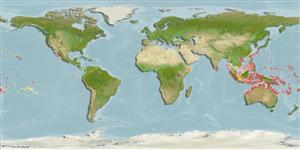>
Eupercaria/misc (Various families in series Eupercaria) >
Scaridae (Parrotfishes) > Scarinae
Etymology: Scarus: Greek, skaros = a fish described by anciente writers as a parrot fish; 1601 (Ref. 45335).
More on author: Kner.
Environment: milieu / climate zone / пределы глубины / distribution range
экология
морской ассоциированный с рифами; пределы глубины 0 - 30 m (Ref. 128797), usually 2 - 15 m (Ref. 37816). Tropical; 30°N - 24°S
Pacific Ocean: Christmas Island in the eastern Indian Ocean (Ref. 30874), then from the Philippines to Samoa, north to the Ryukyu Islands, south to the southern Great Barrier Reef.
Size / Вес / Возраст
половая зрелость: Lm ? range ? - ? cm
Max length : 30.0 cm TL самец/пол неопределен; (Ref. 2334)
Краткое описание
определительные ключи | морфология | морфометрия
колючие лучи спинного плавника (общее число) : 9; членистые (мягкие) лучи спинного плавника (общее число) : 10; колючие лучи анального плавника: 3; членистые (мягкие) лучи анального плавника: 9. Males distinct and head looks bright yellow underwater; females drab with white teeth and some pale spots (Ref. 48636). Scales large. 4 median predorsal scales; a transverse pair of smaller scales which overlap medially in mid-dorsal line located directly anterior to 1st median scale; 3 scale rows on cheek, lower row with 1-2 (usually 2) scales. Caudal fin slightly rounded to truncate in initial phase; moderately to deeply emarginate in terminal phase. Adults in initial phase without canines on upper plate, 1 on lower; terminal-phase fish with 1-2 canines on upper and lower plates. Lips largely or entirely cover dental plates.
Body shape (shape guide): elongated; Cross section: compressed.
Inhabits coral-rich areas of outer lagoon and seaward reefs (Ref. 9710). Usually solitary (Ref. 9710). Females usually in small groups with a male nearby; they may mix with females of similar species (Ref. 48636). An uncommon fish patchily distributed through much of its range.
Life cycle and mating behavior
половая зрелость | размножение | нерест | икра | Fecundity | личинки
Oviparous, distinct pairing during breeding (Ref. 205).
Randall, J.E., G.R. Allen and R.C. Steene, 1990. Fishes of the Great Barrier Reef and Coral Sea. University of Hawaii Press, Honolulu, Hawaii. 506 p. (Ref. 2334)
Статус Красного Списка МСОП (Ref. 130435: Version 2025-1)
Угроза для людей
Harmless
Использование человеком
дополнительная информация
инструменты
Специальные отчеты
Скачать в формате XML
ресурсы в Интернет
Estimates based on models
Preferred temperature (ссылка
123201): 25 - 29.3, mean 28.5 °C (based on 2066 cells).
Phylogenetic diversity index (ссылка
82804): PD
50 = 0.5000 [Uniqueness, from 0.5 = low to 2.0 = high].
Bayesian length-weight: a=0.01000 (0.00422 - 0.02368), b=3.09 (2.90 - 3.28), in cm total length, based on LWR estimates for this Genus-body shape (Ref.
93245).
Trophic level (ссылка
69278): 2.0 ±0.00 se; based on food items.
устойчивость к внешним воздействиям (ссылка
120179): высокий, минимальное время удвоения популяции до 15 месяцев (Preliminary K or Fecundity.).
Fishing Vulnerability (Ref.
59153): Low vulnerability (20 of 100).
🛈
Nutrients (Ref.
124155): Calcium = 56.3 [31.4, 96.2] mg/100g; Iron = 0.782 [0.504, 1.329] mg/100g; Protein = 18.1 [16.0, 19.9] %; Omega3 = 0.058 [0.034, 0.099] g/100g; Selenium = 20.3 [10.3, 37.1] μg/100g; VitaminA = 50.8 [12.7, 199.7] μg/100g; Zinc = 2.5 [1.8, 3.4] mg/100g (wet weight);
